Punjab State Board PSEB 12th Class Maths Book Solutions Chapter 10 Vector Algebra Ex 10.4 Textbook Exercise Questions and Answers.
PSEB Solutions for Class 12 Maths Chapter 10 Vector Algebra Ex 10.4
Question 1.
Find \(|\overrightarrow{\boldsymbol{a}} \times \overrightarrow{\boldsymbol{b}}|\), if \(\overrightarrow{\boldsymbol{a}}\) = î – 7ĵ + 7k̂ and \(\overrightarrow{\boldsymbol{b}}\) = 3î – 2ĵ + 2k̂.
Solution.
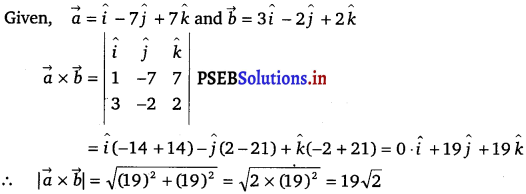
![]()
Question 2.
Find a unit vector perpendicular to each of the vector \(\overrightarrow{\boldsymbol{a}}+\overrightarrow{\boldsymbol{b}}\) and \(\overrightarrow{\boldsymbol{a}}-\overrightarrow{\boldsymbol{b}}\), where \(\overrightarrow{\boldsymbol{a}}\) = 3î + 2ĵ + 2k̂ and \(\overrightarrow{\boldsymbol{a}}\) = î + 2ĵ – 2k̂.
Solution.
Given, \(\overrightarrow{\boldsymbol{a}}\) = 3î + 2ĵ + 2k̂ and \(\overrightarrow{\boldsymbol{a}}\) = î + 2ĵ – 2k̂.
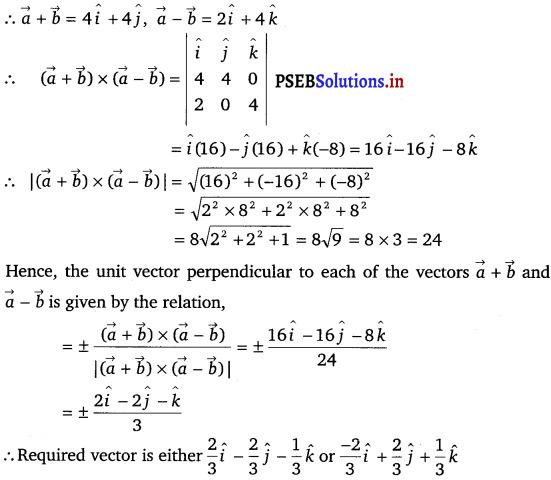
![]()
Question 3.
If a unit vector \(\overrightarrow{\boldsymbol{a}}\) makes angles \(\frac{\pi}{3}\) with î, \(\frac{\pi}{4}\) with ĵ and an acute angle θ with k, then find θ and hence, the components of \(\overrightarrow{\boldsymbol{a}}\).
Solution.
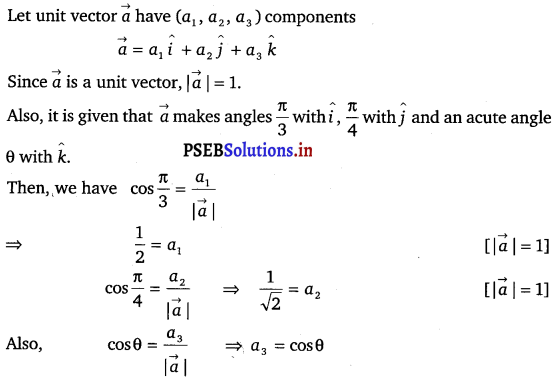
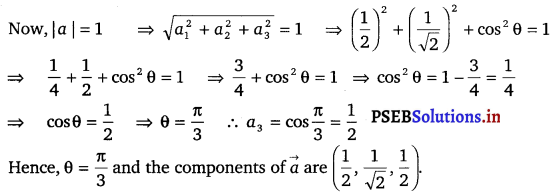
![]()
Question 4.
Show that \((\vec{a}-\vec{b}) \times(\vec{a}+\vec{b})=2(\vec{a} \times \vec{b})\)
Solution.

Question 5.
Find λ and µ if (2î + 6ĵ + 21k̂) x (î + λĵ + µk̂) = 0.
Solution.
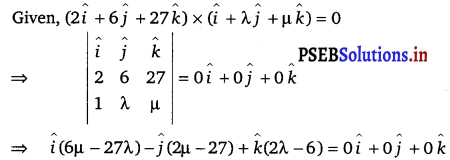
On comparing the corresponding components, we have
6µ – 27λ = 0,
2µ – 27 = 0,
2λ – 6 = 0
Now, 2λ – 6 = 0
⇒ λ = 3
2µ – 27 = 0
⇒ µ = \(\frac{27}{2}\)
Hence, λ = 3 and µ = \(\frac{27}{2}\).
![]()
Question 6.
Given that \(\overrightarrow{\boldsymbol{a}} \cdot \vec{b}\) = 0 and \(\overrightarrow{\boldsymbol{a}} \times \overrightarrow{\boldsymbol{b}}\) = 0. What can you conclude about the vectors \(\overrightarrow{\boldsymbol{a}}\) and \(\overrightarrow{\boldsymbol{b}}\)?
Solution.

Question 7.
Let the vectors \(\overrightarrow{\boldsymbol{a}},\), \(\overrightarrow{\boldsymbol{b}},\), \(\overrightarrow{\boldsymbol{c}},\) be given as a1i + a2j + a3k, b1i + b2j + b3k, c1i + c2j + c3k. Then show that \(\vec{a} \times(\vec{b}+\vec{c})=\vec{a} \times \vec{b}+\vec{a} \times \vec{c}\).
Solution.
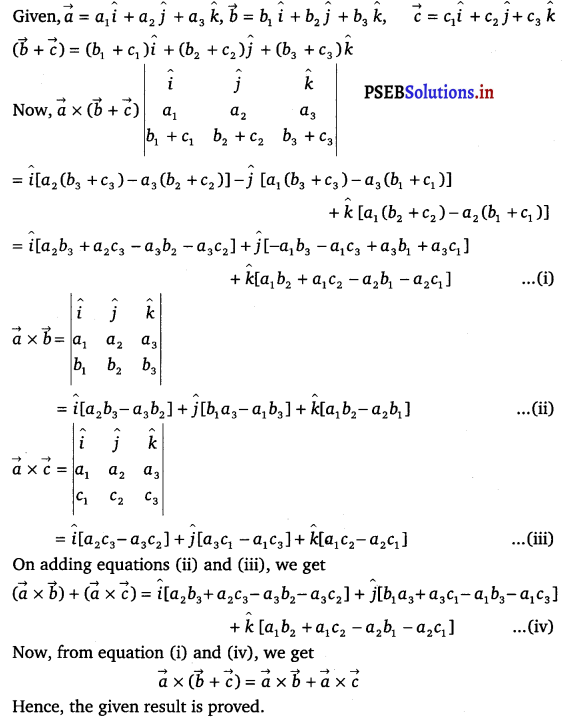
![]()
Question 8.
If either \(\vec{a}=\overrightarrow{0}\) or \(\overrightarrow{\boldsymbol{b}}=\overrightarrow{\mathbf{0}}\), then \(\vec{a} \times \vec{b}=\overrightarrow{0}\). Is the converse true? Justify your answer with an example.
Solution.

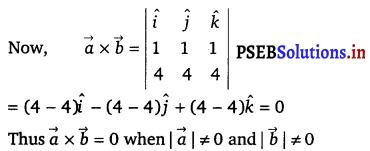
Question 9.
Find the area of the triangle with vertices A ( 1, 1, 2), B (2, 3, 5) and C(1, 5, 5).
Solution.
The vertices of triangle are given asA(1, 1, 2), B(2, 3, 5) and C(1, 5, 5).
The adjacent sides \(\overrightarrow{A B}\) and \(\overrightarrow{B C}\) of ∆ABC are given as
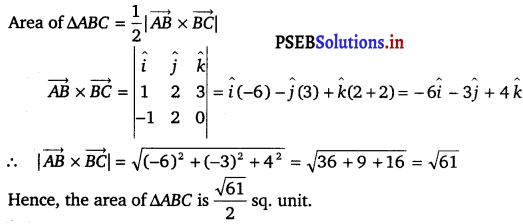
![]()
Question 10.
Find the area of the parallelogram whose adjacent sides are determined by the vectors \(\overrightarrow{\boldsymbol{a}}\) = î – ĵ + 3k̂ and \(\overrightarrow{\boldsymbol{b}}\) = 2î – 7ĵ + k̂.
Solution.
The area of the parallelogram whose adjacent sides are \(\overrightarrow{\boldsymbol{a}}\) and \(\overrightarrow{\boldsymbol{b}}\) is \(|\vec{a} \times \vec{b}|\).
Adjacent sides are gives as
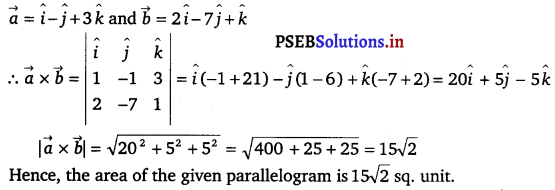
![]()
Question 11.
Let the vectors \(\overrightarrow{\boldsymbol{a}}\) and \(\overrightarrow{\boldsymbol{b}}\) be such that \(|\overrightarrow{\boldsymbol{a}}|\) = 3 and \(|\vec{b}|=\frac{\sqrt{2}}{3}\) then \(\overrightarrow{\boldsymbol{a}} \times \overrightarrow{\boldsymbol{b}}\)
is a unit vector, if the angle between \(\overrightarrow{\boldsymbol{a}}\) and \(\overrightarrow{\boldsymbol{b}}\) is
(A) \(\frac{\pi}{6}\)
(B) \(\frac{\pi}{4}\)
(C) \(\frac{\pi}{3}\)
(D) \(\frac{\pi}{2}\)
Solution.
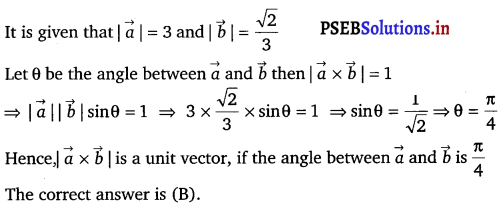
![]()
Question 12.
Area of a rectangle having vertices A, B, C and D with position vectors – î + \(\frac{1}{2}\) ĵ + 4k̂, î + \(\frac{1}{2}\) ĵ + 4k̂, î – \(\frac{1}{2}\)ĵ + 4k̂ and – î – ĵ + 4k̂ respectively is
(A) \(\frac{1}{2}\)
(B) 1
(C) 2
(D) 4
Solution.
The position vectors of vertices A, B, C and D of rectangle ABCD are given as
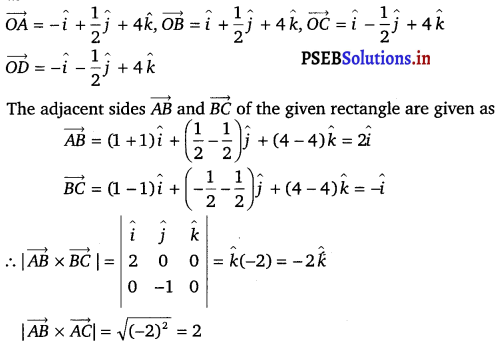
Now, it is known that the area of a parallelogram whose adjacent sides are \(\vec{a}\) and \(\vec{b}\) is |\(\vec{a} \times \vec{b}\)|.
Hence, the area of the given rectangle is |\(\overrightarrow{A B} \times \overrightarrow{B C}\)| = 2 sq unit.
The correct answer is (C).
